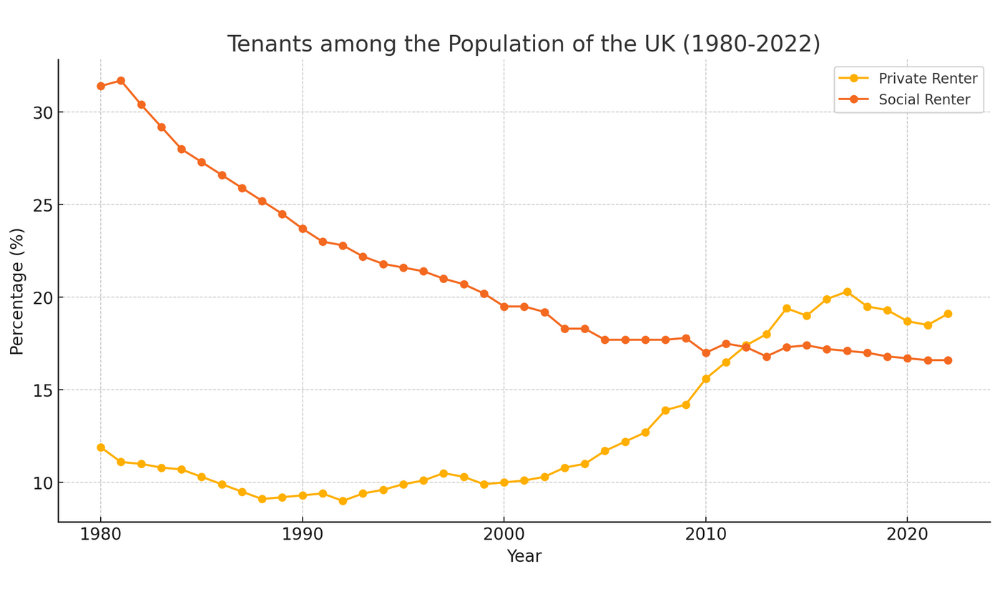Big lender looks to grow business by a third

The UK build-to-rent sector has just reached it’s 100,000th home milestone, and at least one major mortgage lender has targeted substantial growth in the sector.
NatWest has announced its intention to expand further into the build-to-rent (BTR) sector, and says it is aiming to grow its lending portfolio in the space to £2 billion by the close of 2025. The move reflects the bank’s growing focus on the private rental market and is part of a broader strategy to capitalize on rising borrower demand.
Read more: UK rents hit a record high
NatWest is already active in the area - in August, the bank provided £85 million in investment funding to Related Argent for its residential development at King’s Cross, London. This loan replaced the construction finance previously managed by Oaktree Capital Management.
The bank is feeling confident that it can expand its loan book within the BTR market, particularly given its recent performance in what remains a competitive but challenging financial environment.
Neil Young, CEO of UK group Get Living, feels confidence from investors is increasing. The rise in the number of BTR homes is providing more data to analyse and expertise to benefit from.
“UK and local governments are actively supporting the sector,” Young told NatWest, “and, while there is still much to be done on the planning side, there is an overall embracing of what BTR can do to support housing delivery.”
And it’s not just millennials in landlords’ sights. “Senior living is entering the minds of some BTR players,” Arthur McCalmont, senior director at CBRE Residential Capital Markets, said. “Firms like Quintain and Delancey are producing data to show there is demand for BTR homes from those in their 60s and 70s.
“There’s also a move to a more mid-market approach. We’ve had a lot of high-end apartments, with BTR developers focusing on the luxury market. But as BTR moves into regional cities, there’s an increasing acceptance that it can work in areas where rents are lower and that mid-market products will work as well as the luxury end.”
Read more: Is buy-to-let getting too hard?
NatWest’s push into the BTR sector began in 2016, with the initial goal of achieving £1 billion in commitments. Since then, the lender has steadily built its presence, bringing its overall BTR lending to £1.5 billion as of this year.
Tom Sharman, NatWest’s head of real estate research and strategy, highlighted that the expansion has been driven by heightened activity within the sector and strong interest from investors and developers.

Recent lending deals and collaborations
NatWest has played a key role in multiple high-profile financing deals within the BTR sector. In September 2023, the bank provided £150 million in funding to Casa by Moda, a brand specializing in single-family rentals. This was followed by a £126 million facility arranged alongside Santander UK, which was directed toward the development of Circle Square in Manchester. Additionally, in 2021, NatWest took part in a £265 million club deal, joining forces with Lloyds, ING, and LGIM Real Assets to support a portfolio of private rental assets.
Growth factors and market opportunities
Explaining the bank’s increased appetite for BTR financing, Sharman cited several market developments. “First and most importantly, the size of the market has steadily increased; there are more players getting established in the sector and therefore more opportunities out there to lend,” Sharman noted.
He also emphasized that the pandemic acted as a stress test for the sector, and its ability to weather that crisis unscathed provided the bank with greater confidence in the market’s resilience. NatWest has also identified the rising demand for single-family rental properties as a key opportunity, with increasing capital flowing into this niche area.
Growing investment volumes in the BTR sector
The BTR sector has seen considerable growth in investment volumes. According to property consultant Knight Frank, the UK’s BTR market attracted over £2.6 billion in investment in the first half of 2024, surpassing the previous high of £2.3 billion recorded in the first half of 2021. This sustained growth underscores the sector’s growing importance within the broader real estate market. Savills says that the rental returns offered by the sector outperform the rest of the private rental sector, helping drive the interest.
Knight Frank found that most of the deals made in Q2 (over 90%) were to fund the construction of almost 4,000 new Build to Rent homes, totalling over £1.2 billion worth of investment.
These projects, managed by professional operators, mark a decade of steady growth since institutional investors first entered the private rental sector (PRS) at scale. Notable early investments included Delancey’s purchase of the Athlete’s Village in East London and M&G’s acquisition of Berkeley’s rental portfolio in 2013.
Read more: Landlords back report urging action on rental supply crisis
Despite the progress, BTR homes currently account for only 2% of the PRS market, but the sector’s potential remains huge. As the market shifts from small-scale landlords to institutional ownership, expectations are that the proportion of homes owned by large-scale investors will steadily increase. Achieving 10% institutional ownership in the PRS would require adding another 480,000 units to institutional portfolios, an ambitious yet attainable goal within the next decade.
Attractive returns and investment trends in BTR
BTR has proven attractive to investors, offering better rental growth and higher-quality housing stock compared to the broader PRS. Over the past 20 years, rental growth in the sector has averaged 3.2% annually. Forecasts indicate that rental values will continue to outperform house prices over the next two years, further supporting investment returns.
The sector’s appeal to investors is also reflected in changing market dynamics. In 2023, 50% of BTR investments came from new entrants, a significant jump from 20% in 2018. As the sector matures, a growing share of global capital is entering the market, drawn by the potential for stable returns and long-term growth. Institutional investors are also showing increasing interest in housing as infrastructure, viewing rented housing—both private and affordable—as essential to urban development.
Growing development pipeline and market consolidation
The BTR pipeline is expanding rapidly, with 110,000 homes currently in planning—the largest pipeline on record. Industry observers believe that, much like the student housing sector, BTR will begin to double in size every few years. Having laid the groundwork through planning, funding, and partnerships, the sector is now positioned for faster growth in the coming decade.
Investment levels are expected to rise to £300 billion, with much of the focus on urban BTR apartment projects. Core cities outside London are playing an increasingly important role, with recent developments in cities like Manchester, Birmingham, and Leeds demonstrating strong rental demand and robust lease-up rates.
Ben Beadle, chief executive of the National Residential Landlords Association told Mortgage Introducer: “Renters across the country are struggling due to a chronic shortage of homes to rent to meet demand. They need more choice. As the commission notes, both institutional and private landlords have a critical role to play in meeting the country’s housing needs.”
Institutional growth and market comparisons
While the UK’s institutional PRS sector is still relatively small, the ambition to scale up is evident. Of the 100,000 operational BTR homes today, approximately 90,000 are urban apartments with a combined value of £35 billion, two-thirds of which are located in London. Regional cities have narrowed the gap in recent years as investors gain confidence in rental growth beyond the capital.
The scale of BTR operations in the UK remains modest compared to international markets. Germany’s largest investor, Vonovia, owns 485,000 homes—almost five times the size of the entire UK BTR sector. In the US, institutional ownership accounts for 41% of the PRS, while Germany sees 37%. If the UK achieves similar levels of institutional ownership, it would mean 2.1 to 2.4 million PRS homes under institutional control, compared to just 100,000 today.
Shift toward operational investment and new market entrants
Historically, most BTR investments have focused on funding new developments. However, a shift is underway, with more capital now flowing into fully operational assets. In Q1 2024, 60% of BTR investment targeted stabilised schemes, marking the highest proportion since 2015. Recent deals, such as KKR’s acquisition of Alameda and Beton at Wembley Park, highlight new investors entering the market through operational stock purchases.
Over the next decade, operational investments are expected to take a growing share of the market, increasing from 25% between 2024 and 2028 to 30% by 2033. With more quality schemes becoming available, the trend towards bundling multiple properties into larger portfolios is likely to mirror the consolidation seen in the student accommodation sector. As a result, some assets may trade multiple times over the next decade.
Valuation shifts and changing rental dynamics
As the BTR sector matures, valuation models are evolving. Traditionally, BTR properties were valued using Vacant Possession (VP) metrics, ensuring the asset’s value could be realised if sold to owner-occupiers. However, with rental demand far outpacing sales price growth—particularly in cities like London, Manchester, and Birmingham—there is growing momentum towards income-based valuations. In some boroughs of London, annual rental growth has exceeded 10%, compared to house price growth of just 1-2%.
To facilitate this shift, greater transparency in performance data is essential. Investors and valuers will need reliable data on net income streams to justify higher valuations based on rental income. As new, amenity-rich schemes continue to perform well, the reliance on traditional VP metrics is expected to decline.
Future opportunities in BTR growth
As the BTR market continues to evolve, investors are drawing inspiration from the hospitality sector, offering additional services to enhance revenue streams. Many schemes now provide optional services such as personal training, in-house cleaning, and ultra-fast internet packages. This trend towards ancillary income not only boosts returns but also aligns with the lifestyle expectations of modern renters.
With growing competition and demand, BTR investors are set to play a crucial role in reshaping the UK housing market. The next decade promises significant growth, with larger, higher-quality schemes becoming the norm. As the sector gains further traction, the gap between UK institutional ownership and more mature international markets is likely to narrow, unlocking new opportunities for large-scale investment.



